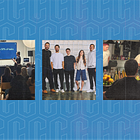Org Charts Are About to Change Forever
Merging Tech and People...
Those separate Miro boards, one for the org chart and one for the tech stack, are about to merge.
For years, we’ve treated them like two different worlds: one showing the people who do the work, the other showing the tools that help them do it. But that distinction is starting to blur. As automation, orchestration, and AI agents become part of everyday operations, the question isn’t who does the work or what does the work, it’s how the work gets done at all.
The line between people and technology isn’t just getting thinner. It’s disappearing.
The Great Divide
For as long as businesses have existed, they’ve been structured around people. The org chart showed command and accountability. The tech stack sat off to the side, a supporting cast of tools, software, and spreadsheets.
That separation made sense when technology’s role was to help humans perform better. You used a system to complete a task, a dashboard to make a decision, an automation to shave a few minutes off a repetitive process. Tech didn’t exist on its own; it was an extension of the operator.
But we’ve reached a point where that hierarchy doesn’t hold anymore.
Software now manages software. Systems talk to systems without human mediation. Data moves, transforms, and triggers action before anyone even logs in. When you have a workflow engine orchestrating decisions across tools, you’re no longer just managing software. You’re managing a workforce made up of both people and logic.
That’s not an incremental change. It’s structural.
The Inflection Point
The shift we’re seeing isn’t theoretical. It’s already happening inside some of the best-run eCommerce brands.
AI agents and orchestrators have made it possible to automate roughly a third of today’s operational workload. We’re not talking about replacing people, but about redistributing what they focus on. Thirty percent of CX tickets resolved without human input isn’t a dream, it’s happening.
And once you’ve seen that in action, you start to realise the entire shape of your team begins to change. Tasks that once sat under “CX” or “Ops” are now owned by a combination of automations, APIs, and intelligent workflows. People move up the stack, managing systems rather than managing outputs.
At that point, it makes no sense to have your org chart and your tech stack living in separate places. They are the same thing. They represent the same system, one that’s half human, half digital, but fully integrated.
Enter Operator Experience
To make sense of this convergence, we need a new language, something that sits between technology and human behaviour. That’s where Operator Experience comes in.
For years, we’ve obsessed over UX and CX, how customers and users interact with systems. But internally, the people who run those systems have been left with duct-taped workflows, half-connected tools, and inconsistent data. Operator Experience, or OX, fixes that gap.
Every brand that scales smoothly already cares about OX, whether they call it that or not. They obsess over stock turn, data accuracy, and the fluidity of internal systems. They understand that efficiency isn’t about working harder, it’s about making the machine run cleaner.
What’s changed in 2025 is that the incentive to take OX seriously has reached a tipping point. The arrival of AI-driven orchestration means you can now automate the equivalent of 30% of your current tasks. That’s not incremental productivity. That’s exponential.
I’ve written about OX2030 before and AI and the future of retail is going to be shaped by the operators:
It’s entirely plausible that we’ll see $200–300M brands run by fewer than twenty people outside logistics. They’ll operate with margins their competitors can’t touch, and they’ll reinvest those gains in growth levers like PPC, product development, and pricing power.
That’s what happens when Operator Experience stops being a background concern and starts becoming a competitive advantage.
What the New Org Chart Looks Like
If you drew a brand’s structure today, you’d still see people in boxes. But tomorrow’s org chart will have systems sitting alongside them, not as support, but as team members.
A CX Manager will oversee a workflow that handles 60% of inbound tickets automatically. A Finance Lead will have a reconciliation bot reporting to them. The Ops Director will spend their time optimising orchestrations instead of signing off POs.
This is what happens when your organisational design and your system architecture converge. Roles evolve from execution to orchestration. Accountability shifts from individuals to flows. And culture adapts, because once machines are part of the structure, management becomes less about supervision and more about system design.
Brands that embrace this will move faster, adapt quicker, and scale leaner. The ones that don’t will drown in complexity, stuck in the mindset that people and tech belong on different diagrams.
The Competitive Advantage
This isn’t a distant future. It’s already happening quietly in some corners of the industry, the kind of places where process and system design are treated with the same care as branding or product.
Those brands are running leaner teams, faster decision loops, and tighter control of data. Their operators aren’t chasing spreadsheets; they’re directing systems. They’re achieving scale not through headcount, but through design.
Meanwhile, everyone else is still trying to hire their way out of inefficiency.
The Merge Has Already Begun
Some brands are already mapping their org chart and tech stack as a single living system, humans, tools, workflows, and automations coexisting on one canvas. Others are still managing them in isolation, heads firmly in the sand.
But the direction of travel is clear.
The org chart is no longer a map of people. It’s a map of capability, everything that gets work done. And that means your next team member might not have a job title at all.





